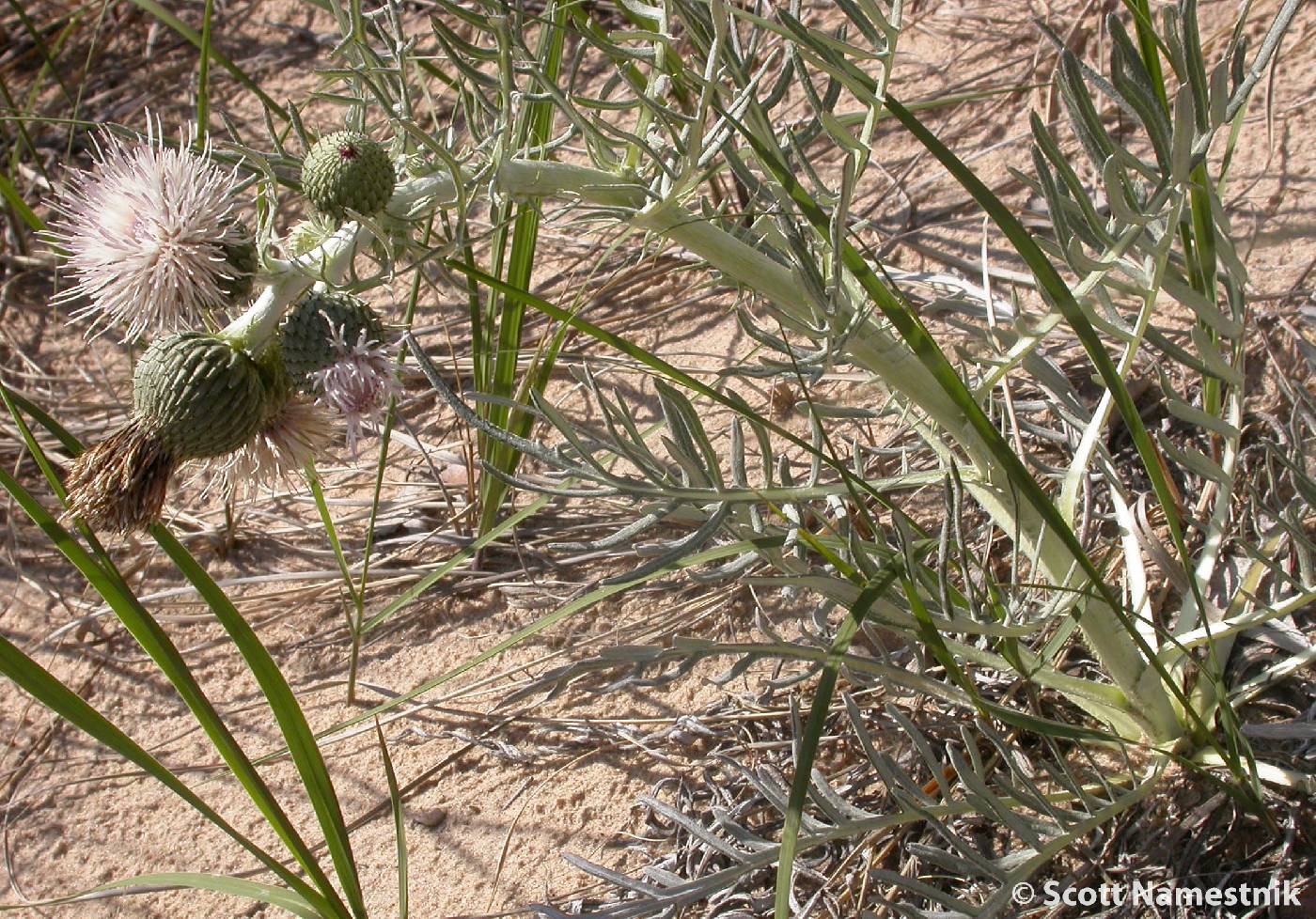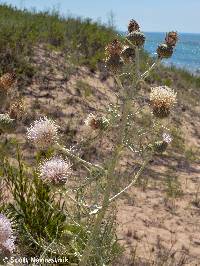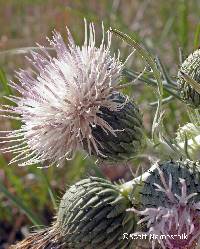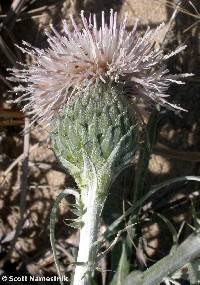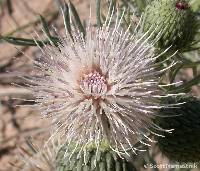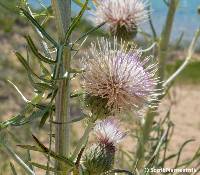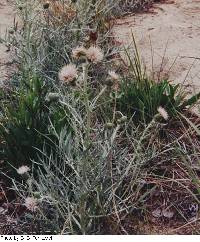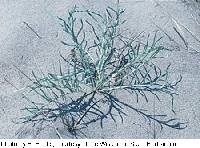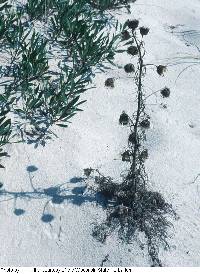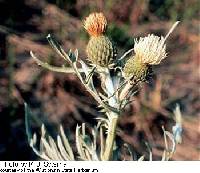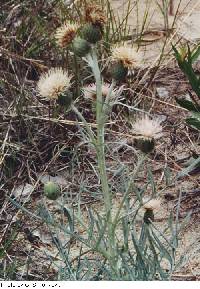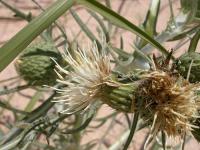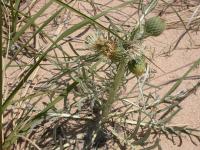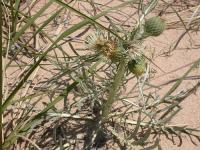Cirsium pitcheri
|
|
|
|
Family: Asteraceae
Sand-Dune Thistle
[Cirsium pitcheri f. magenteum E. G. Voss, moreCnicus pitcheri] |
Biennials or short-lived monocarpic perennials, 20-100 cm; taproots long. Stems 1 or few, erect, densely gray-tomentose; branches 0 to several, ascending to spreading. Leaves: blades elliptic to obovate, 10-30 × 8-14 cm, deeply divided nearly to midveins, lobes ascending to spreading, linear, remote, margins revolute, entire or minutely spinulose, main spines 1-2 mm, faces gray-tomentose, more densely so abaxially; basal present or withered at flowering, petiolate; principal cauline well distributed, bases decurrent as linear-lobed to spiny wings 1-3 cm; distal cauline well developed. Heads 1-20+ in corymbiform arrays. Peduncles 0-5 cm. Involucres ovoid to campanulate, 2-3 × 2-3 cm, loosely arachnoid on phyllary margins or glabrate. Phyllaries in 6-8 series, imbricate, ovate-lanceolate (outer) to linear-lanceolate (inner), abaxial faces with narrow glutinous ridge; outer and middle appressed, acute, spines ascending to spreading, slender, 1-2(-3) mm; apices of inner often flexuous, flattened, spineless, scabrid. Corollas dull white or pinkish-tinged (rarely rich purple), 20-30 mm, tubes 8.5-15 mm, throats 4.5-10 mm, lobes 3-8 mm; style tips 3.5-5.5 mm. Cypselae light brown, sometimes with darker streaks, 6-7.5 mm, apical collars lighter colored, very narrow; pappi 15-30 mm, usually noticeably shorter than corolla. 2n = 34. Flowering spring-summer (May-Sep). Sand dunes and beaches; 180-200 m; Ont.; Ill., Ind., Mich., Wis. Cirsium pitcheri is endemic to beach and dune habitats around lakes Huron, Michigan, and Superior. It has been extirpated from portions of its former range at the southern end of Lake Michigan. It is threatened by foot traffic, off-road vehicular activity, and clearing and development of beachside habitats. It is in the Center for Plant Conservation´s National Collection of Endangered Plants.
Perennial herb that flowers once and then dies 0.5 - 1.3 m tall Stem: only produced when the plant flowers, and then branching in the inflorescence. The stem is blue-green, covered with dense, soft, white hairs, and has very few spines. Fruit: of numerous, small achenes, one from each flower. The achenes are either wind dispersed individually, or remain in the old flower head, which is attached to the stem after flowering, and becomes buried as the parent plant dies and falls over. Root: a taproot, often 2 m long, penetrating deeply. Basal leaves: in a rosette, long-stalked, blue-green, up to 30 cm long (though small in first year), deeply pinnately lobed into very narrow segments, obscurely toothed along the edges, covered with soft white hairs, and with weak, soft spines at the tips of the segments. The basal rosette of leaves may be the only evidence of the plant for several years. Stem leaves: alternate, almost stalkless, very similar to basal leaves, though the blades decrease in size gradually upwards on the stem. Flower heads: several per plant, rather large, up to 5 cm wide. Involucre 2.5 - 3 cm tall, and covered with white hairs on the outer surface. Outer bracts (phyllaries) tipped with 1 - 2 mm long prickles. Inner bracts (phyllaries) longer than the outer ones, and tapering to a long, slender, somewhat soft bristle. Individual flowers: creamy-white (less commonly pale pink), and very fragrant. Similar species: Cirsium pitcheri is the only thistle in the Chicago Region with cream-colored flowers, and it is only found on the near dunes surrounding Lake Michigan. In addition to the flower color and singular location of the species, other diagnostic characters are the blue-green cast of the stem and leaves, the soft white hairs covering the plant, and the absence of numerous, sharp spines on the stem. Flowering: late May to September Habitat and ecology: Open sand in the dunes of Lake Michigan, but currently only existing naturally in the Chicago Region in the dune areas of Indiana and Michigan where it occurs sporadically on exposed sand, primarily near blowouts. The species used to occur on beaches and foredunes, but all populations in the Chicago Region in these habitats have been wiped out. The species requires open, loose sands, which are exceedingly more rare in current times due to recreational uses and land development. Efforts to stabilize dunes have put additional pressure on the species because it decreases habitat availability. Additional problems have arisen with influx of invading exotic species, grazing of plants by deer, rabbits, and insect larvae, and trampling by humans. The coat of white hairs on the plant is adaptive to the harsh, exposed environment. The silky white covering helps reflect sun rays to keep the plant temperature lower and consequently decrease water loss. Occurence in the Chicago region: native Notes: One of a few species that grow only in the Great Lakes region, Cirsium pitcheri occurs on the sand beaches and dunes of Lake Michigan and Lake Huron, and at two localities along Lake Superior. The closest relative of this unique thistle is thought to be C. canescens, which occurs in the sand hills of the Great Plains (Loveless and Hamrick 1988). It is believed that C. pitcheri evolved after the retreat of the Wisconsin ice sheet about 10,000 - 12,000 years ago (Johnson and Iltis 1963, Loveless and Hamrick 1988, Mickelson et al. 1983). The plant requires from five to eight years of growth to achieve its minimum flowering size. The stem and flowering branches are produced only once, since the plant dies after flowering (monocarpic). The flowers are visited by numerous insect pollinators. Seed dispersal is usually clustered within five meters of the parent plant (Keddy and Keddy 1984, Loveless and Hamrick 1988). Due to human impact on the dune environment in our area, this species has suffered great habitat fragmentation, which leads to reproductive isolation. The species was extirpated (extinct) in Illinois in the early 1900's. In 1991, several groups, including the U. S. Fish and Wildlife Service, The Morton Arboretum, and the Chicago Botanic Garden, started work to reintroduce the species in Illinois at the Illinois Beach State Park. Cirsium pitcheri still exists in scattered natural populations throughout the dunes in Indiana (at both the Indiana Dunes National Lakeshore and the Indiana Dunes State Park). The plants are monitored and managed in attempts to continue the existence of viable populations in the area. This species is listed as Threatened under the Federal Endangered Species Act. Etymology: Cirsium comes from both the Greek words kirsion, meaning a kind of thistle, and cirsos, meaning "swollen vein", for which thistles were once thought a remedy. Pitcheri is named after Dr. Zina Pitcher who discovered the plant along Lake Superior between 1826 and 1828. Author: The Field Museum Taprooted biennial or monocarpic perennial, 5-10 dm; stem and lower lf-surfaces densely and persistently white-tomentose, the upper lf-surfaces more thinly so; lvs deeply pinnatifid, with narrow rachis and long, remote, linear, entire or few-toothed, weakly spine-tipped lobes to 8 cm נ7 mm; heads several, white or whitish; invol 2.5-3 cm, its bracts slightly tomentose especially marginally, well imbricate, the inner long-acuminate, the others with weak spine-tip 1-2 mm; achenes 5-7.5 mm; 2n=34. Sand dunes around lakes Michigan and Huron and e. Lake Superior, in Ont., Mich., Wis., Ind., and formerly Ill. May-Sept. Gleason, Henry A. & Cronquist, Arthur J. 1991. Manual of vascular plants of northeastern United States and adjacent Canada. lxxv + 910 pp. ©The New York Botanical Garden. All rights reserved. Used by permission. From Flora of Indiana (1940) by Charles C. Deam This species grows in almost pure, dry sand and is restricted to the dunes near Lake Michigan in Lake and Porter Counties. It probably did occur in La Porte County but I have not seen a specimen from this county. It is commonest in the blow-outs. I planted seed in our garden, and when the plants were three years old I measured the largest one. This plant had a spread of 65 inches, and had 14 decumbent and radiating branches and 1 upright stem that was 28 inches high. The lateral branches had 110 heads, each branch with 5-10 heads. The upright stem had 14 heads. This specimen had about ten times the number of heads that an average specimen has and was several times larger. |
|
|
|

